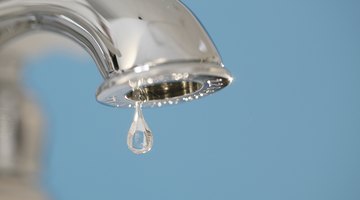How to Fix a Laundry Faucet
Repairing a laundry faucet is slightly different than repairing a regular faucet.If the problem is merely a leak, it can often be repaired by simply tightening the packing nut on top of the faucet with a pair of pliers.However, if this is not the solution, then there may be worn out packing or a corroded washer within.

Things You Will Need
- Pliers
- Adjustable wrench
- Screwdriver (Philips and/or flathead)
- Replacement packing, nuts, or washers (if necessary)
Fortunately, taking the faucet apart is far less tricky than it may seem to be.
-
Turn off the water at either the valve beneath the tub or at the main shutoff valve. The main shutoff valve is usually located in a basement or crawlspace. Drain the excess water from the faucet before beginning to avoid a mess.
-
Remove any decorative cap that may snap or screw on top of the handle. If pliers are necessary, pad them with something to avoid damaging anything. Use the screwdriver to unscrew the handle (if you have an older sink, the handle may not even be attached to the faucet).
-
Remove the packing nut (the final piece separating the actual faucet from the pieces you have removed) by twisting it counter-clockwise with the wrench. This will expose the packing.
-
Being careful to note which way it was put on, unwrap the packing. Examine its condition: if it looks worn and thin, it may need to be replaced.
-
Remove the entire stem by unscrewing it, and examine its condition.A clog inside is an obvious indicator of a problem.Gently clean away any chips on the exposed faucet cavity with a non-abrasive cleaning tool like a rag.Clean the threads on the stem and be certain they are not damaged or worn down.
-
Take a close look at the washer on the stem's lower end and the brass screw holding it in.If the washer is flat, grooved, or worn, it needs to be replaced.Check for damage on the screw as well.
-
Take any damaged parts such as a packing nut, packing, stem, handle, washer, or brass screw to a hardware store and have an associate help you replace them.
-
Reassemble the faucet in the reverse order described above, and turn the water back on.
Tip
If the faucet is still not working correctly or leaking, then there may be internal damage.It is best to contact a plumber in this case, as it can be difficult to diagnose more serious problems without the proper training.
Warning
Exercise caution when working with plumbing. Always be sure that the hot water is not turned on.
References
Tips
- If the faucet is still not working correctly or leaking, then there may be internal damage.It is best to contact a plumber in this case, as it can be difficult to diagnose more serious problems without the proper training.
Warnings
- Exercise caution when working with plumbing. Always be sure that the hot water is not turned on.
Writer Bio
Peter H. Crawford has been writing professionally since 2004. After studying journalism and English at The Ohio State University, he immediately began composing and reviewing for various publications about dining, nightlife, travel and music. His work has appeared in literature from Chicago to Los Angeles, and all over the nation.
Photo Credits
- Comstock/Comstock/Getty Images
- Comstock/Comstock/Getty Images
More Articles



